Cold lists and spreadsheets made sense a decade ago, but they slow you down now. Buyers move quickly, and your outreach needs to match their pace.
A recent survey on email marketing AI trends shows 29% of marketers expect AI-driven content and analytics to reshape email outreach next year. 70% predict AI will run up to half of their email workflows by 2026, and 18% even see it tackling most tasks.
If you want a healthier pipeline, you need software that can find leads and learn from feedback. The challenge lies in picking a platform that fits the way you sell, not the way a vendor says you should.
The list below breaks down eight AI sales prospecting tools worth your attention.
Don’t Get an AI Sales Tool Without Checking These First
Weigh each platform against the checkpoints below before you pick one for your sales team.
Data Integration
Your prospecting workflows run smoother when the platform ties into customer relationship management systems (CRMs) without extra data entry. Look for a direct sync that pushes fresh sales data into your reports and pulls intent data back into outreach.
Customization
Generic messaging falls flat. You need flexible fields, sequences, and templates that let sales reps create personalized outreach for high-potential leads. A rigid setup forces you to bend your voice to fit the tool, not the other way around.
Performance Metrics
Real-time dashboards keep sales professionals focused on open rates, reply rates, and booked meetings. Skip any prospecting tool that hides basic analytics or requires manual research just to see whether your last cadence worked.
User Friendliness
Clear menus and quick onboarding help the entire team get value in the first week. If you need a one-hour demo just to launch a campaign, keep looking.
Scalability
Your lead generation targets will grow. Make sure the platform handles more inboxes, larger contact lists, and extra users without painful upgrades.
Adaptive Intelligence
A modern AI-powered platform learns from past outreach, applies predictive analytics, and scores prospects based on buying signals. That adaptive layer turns outbound prospecting into a cycle of smarter decision-making.
The Best AI Tools for Sales Prospecting
These AI tools help you find better leads faster.
1. Village
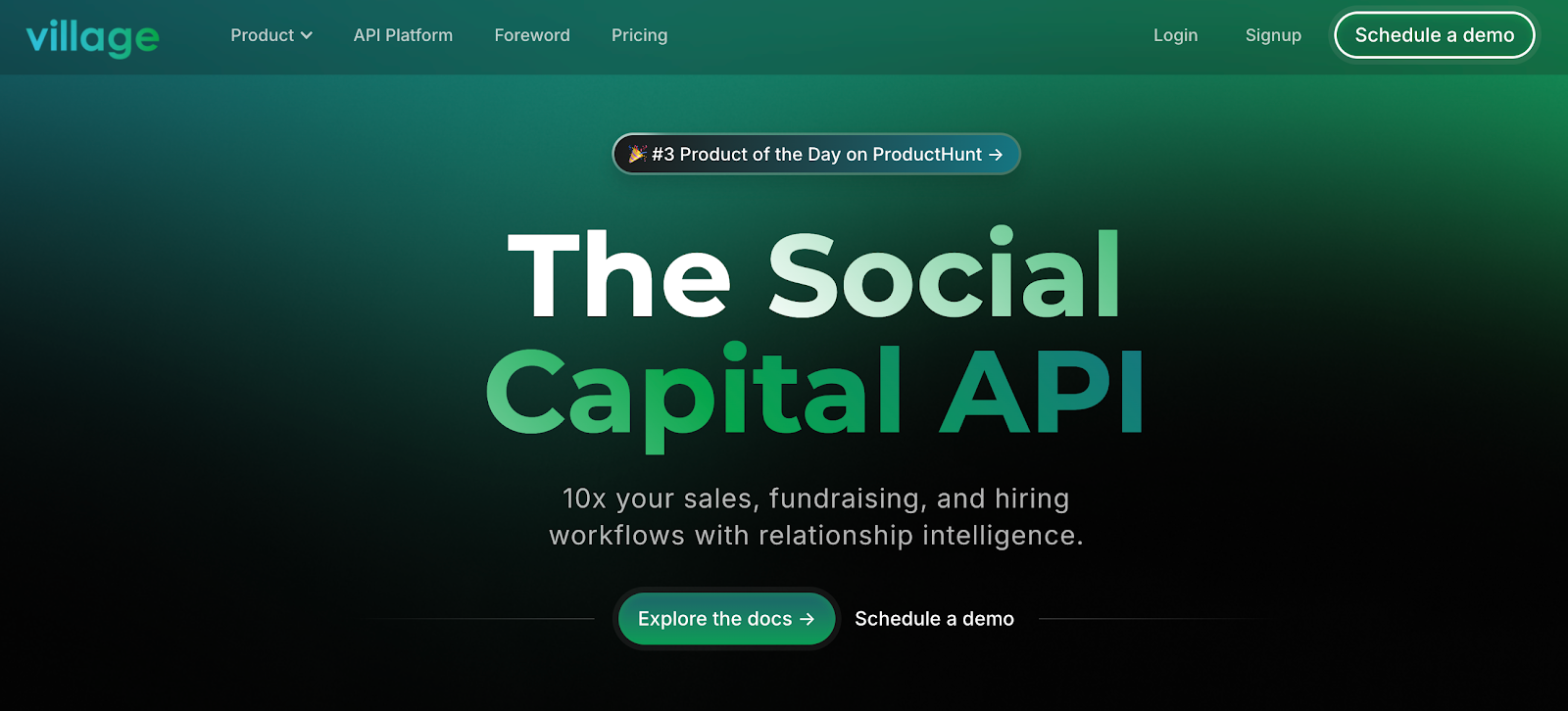
Cold outreach burns time and often gets ignored. Village helps your sales team reach out through warm, verified connections. It’s not a contact list. Village unlocks qualified leads by mapping real relationships you already have but aren’t using yet.
Ideal for: Turning warm referrals into booked calls without wasting hours on manual research or ignored cold emails.
How Does Village Work?
Village connects your contact data, calendars, and LinkedIn profiles to surface trusted introductions across your entire network. Instead of cold messages, you send requests through mutual connections. That builds trust from the first customer interaction.
You can sort results by context, such as shared deals, mutual investors, or past team collaborations. This adds clarity and relevance to each intro request and helps you send more personalized messages that match intent.
Standout Features
- Network syncing: Pulls LinkedIn profiles, calendars, and contacts into one graph.
- AI scoring: Highlights the shortest route to buyers using intent signals and predictive analytics.
- Intro workflow: Creates double-opt-in requests and tracks each step inside your customer relationship management (CRM) system.
- Actionable insights: Surface past deals and shared investors so you can send personalized messages.
Pricing
- Free trial
- Essentials: $19/month for unlimited AI search and up to 3 warm intro paths per person
- Pro: $39/month adds team collaboration and up to 6 intro paths
- Premium: $119/month for unlimited intros and API access
- API Platform: $499/month for full integration into your platform
Start with a demo or join Village for free!
2. Apollo
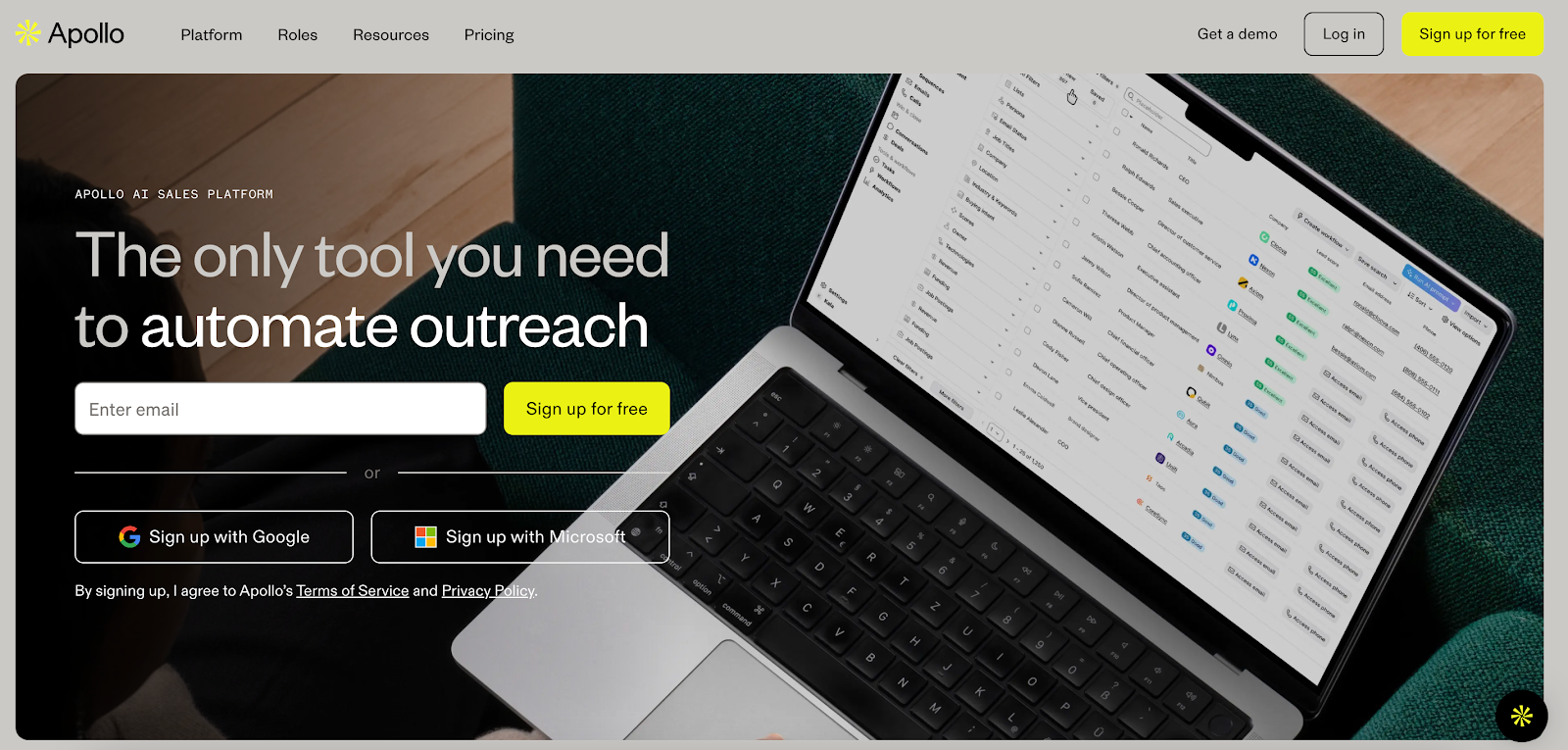
Hitting aggressive sales goals means you need data that points reps toward potential customers who already show buying clues. Apollo brings together a giant database, AI for sales prospecting, and workflow tools, replacing manual tasks with guided outreach.
Good for: Teams that run high-volume prospecting efforts and want data-driven insights for tighter lead targeting.
How Does Apollo Work?
Apollo tracks over 60 million companies and 275 million contacts, then layers in machine learning to surface lead scoring, job changes, and intent signals.
You filter by industry, tech stack, or funding stage, and drop your picks into a sequence. Then, Apollo's built-in AI assistant drafts engaging messages across email, phone, and LinkedIn.
Standout Features
- Buying intent and AI-driven insights that highlight accounts researching your niche
- Lookalike engine that finds more prospects matching your best customers
- Analytics that analyze data from each touch to flag what boosts sales performance
- Native CRM sync to cut extra data entry and keep account executives in one view
Pros
Apollo cuts down time-consuming research by serving verified emails, direct dials, and account details in one place. The generative AI follow-up tool also mirrors tone, saving reps from rewriting every reply manually.
Cons
The AI-generated copy still needs human input. Some responses feel generic or slightly off. If you're considering the Organization plan, it requires a three-user minimum and only offers annual billing.
Pricing
- Free
- Basic: $59 per user per month
- Professional: $99 per user per month
- Organization: $149 per user per month, annual billing only
3. Cognism
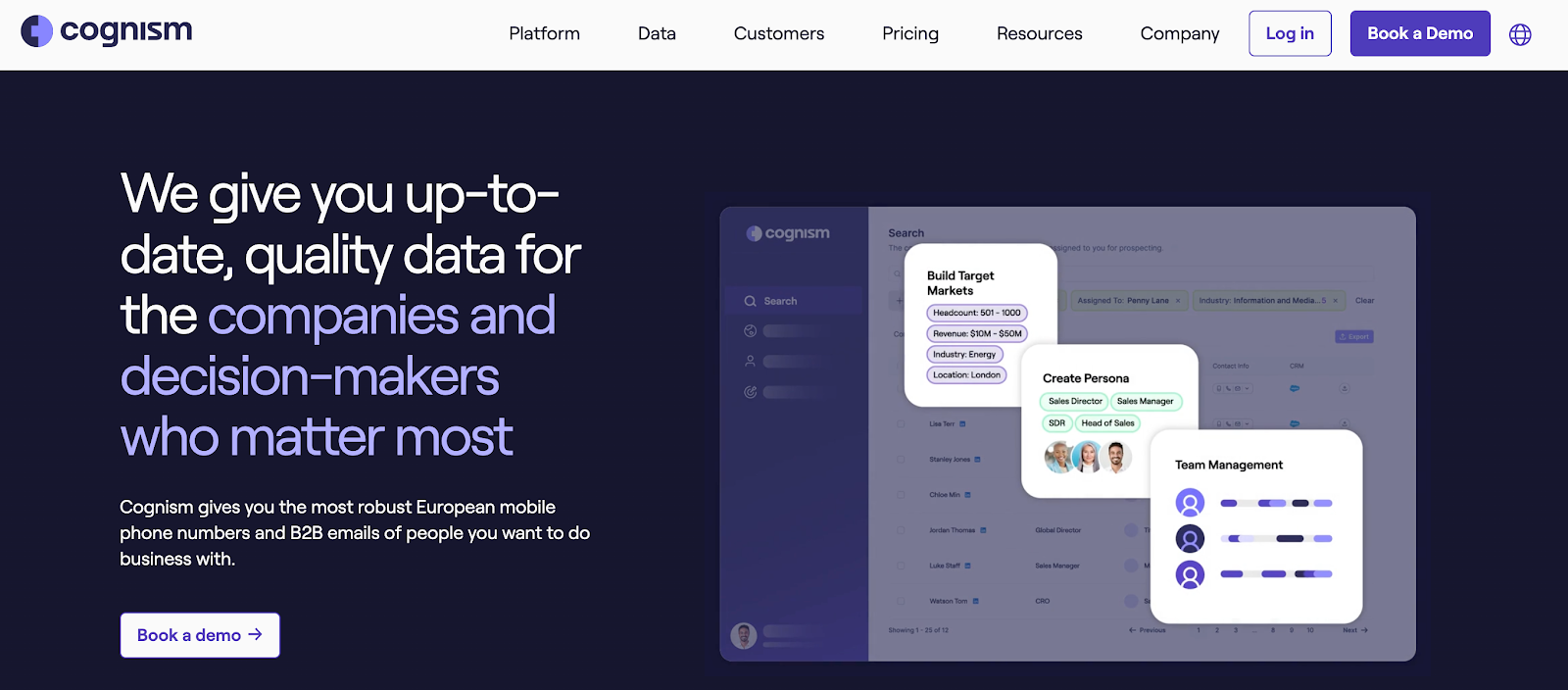
If you sell across regions with strict privacy laws, you need data you can trust. Cognism gives your team verified phone numbers and emails backed by Diamond Data. This helps you reach potential customers without worrying about penalties.
Good for: Teams that care about accurate contact data, fast lead prioritization, and privacy compliance.
How Does Cognism Work?
Type or speak a request such as “VPs of Sales at software companies in London,” and Cognism returns a list ready for outreach.
The AI for sales prospecting engine pulls intent signals, past sales activities, and real-time job changes to surface the hottest accounts. Representatives push those contacts to the CRM, then start campaigns with email, phone, or LinkedIn.
Standout Features
- AI Search that cuts manual tasks by letting you use plain language or voice commands
- Diamond Data with phone-verified contacts to lift connection rates
- Automatic list sync to your CRM, which removes double data entry
- Ongoing performance monitoring that analyzes data from open and reply rates, then suggests tweaks for higher sales performance
Pros
Cognism stands out for how easy it is to pick up, even if you are new to prospecting tools. The layout is clear, the features are easy to find, and you can move through searches without needing help from a manual.
Cons
Not every contact record is complete. You may run into gaps that require extra digging or a quick double-check against LinkedIn.
Pricing
- Public pricing isn’t available.
4. ZoomInfo
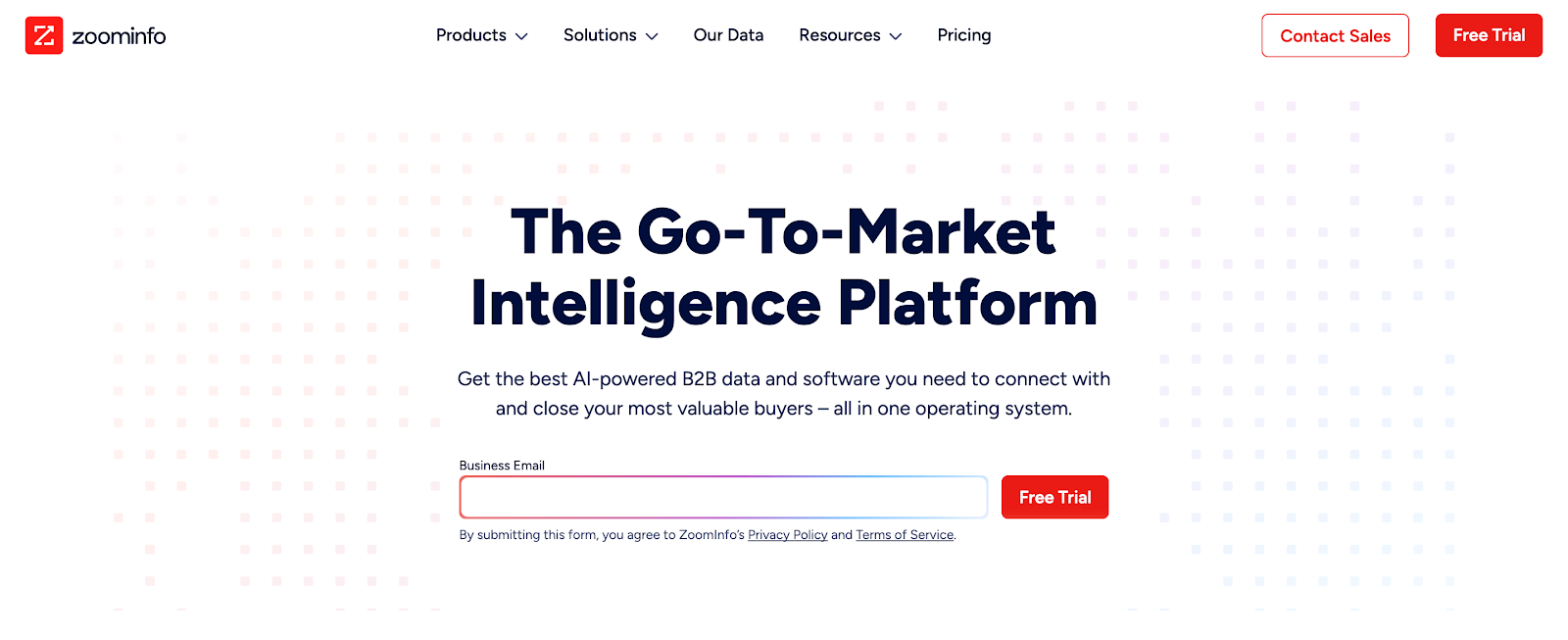
Your sales and marketing teams need fresh signals to cut through crowded inboxes. ZoomInfo mixes a massive database with Copilot. It’s an AI agent that highlights buyers who match your ideal profile.
Good for: Revenue teams that rely on firmographic depth, real-time intent data, and tight CRM sync to keep sales processes on track.
How Does ZoomInfo Work?
ZoomInfo crawls millions of company and professional records, adds predictive analytics such as funding events or leadership moves, then ranks contacts through a “Likely to Engage” lens.
Copilot serves up data-driven insights like lead prioritization and recommended timing, letting you reach out before competitors notice the same spike in research. Chrome and CRM integrations keep the platform close to your daily tools, so you never copy and paste lists.
Standout Features
- Real-time alerts for funding rounds, job changes, and leadership shifts
- “Likely to Engage” scores that point reps toward contacts open to calls, emails, or LinkedIn messages
- List enrichment and de-duplication that reduce manual tasks and bad addresses
- Direct sync with Salesforce and HubSpot to slot leads into existing cadences
- Chrome extension for quick lookups while browsing profiles
Pros
ZoomInfo saves reps from scavenging the web by delivering verified phone numbers, emails, and social links in one search. The tight CRM connection also keeps data current, which helps teams close deals without duplicate records.
Cons
Large file uploads can stall, leaving you waiting for fresh data. The interface feels heavy until you learn its layout, and limited field customization can clash with unique workflows. You'll need to request pricing through sales, which slows budget planning.
Pricing
- ZoomInfo doesn't publish prices publicly.
5. UserGems

You can have solid contact data and still miss the window to close deals. UserGems gives you the timing, context, and tools to connect with buyers before your competitors do.
Good for: Revenue teams looking to boost pipeline without automating repetitive tasks like manual research and contact prioritization.
How Does UserGems Work?
UserGems connects to your CRM and analyzes buying signals like job changes, intent data, and previous champions. Its outbound AI agent builds target lists, scores leads, and drafts email sequences using insights from your past deals.
Your team sees exactly who to reach out to, why they matter, and how to move the deal forward. This helps drive consistent sales success.
Standout Features
- Signal-based prospecting using intent, job changes, and past engagement
- Prioritization scoring across accounts and contacts using all available data
- Ready-to-send outbound messaging personalized by campaign
- A daily list of warm leads who fit your ideal customer profile
Pros
UserGems cuts down research time by surfacing warm prospects automatically. It uses machine learning to uncover high-converting leads and gives you context you can act on. This leads to shorter cycles and stronger conversion rates.
Cons
New job change signals sometimes take time to appear. That works to your advantage since reaching out too early rarely converts well.
Pricing
- Pricing information isn't available for public viewing.
6. Salesloft

If you want to talk to buyers while they are active, not hours later, Salesloft (formerly Drift) gives your sales team that edge. The platform connects chat, automation, and AI agents so you can engage the right visitor before they bounce.
Good for: Teams that sell through live conversations and want to shorten the time between first touch and booked meeting.
How Does Drift Work?
Salesloft monitors your site in real time and flags high-intent accounts as they land. It tracks visitor behavior, uses intent signals to score each session, and then starts a conversation using AI chat. You can qualify leads, collect key data, and offer meeting slots all within the same chat thread.
Standout Features
- AI chat agents that answer questions, qualify leads, and connect prospects to reps live
- Real-time visitor tracking and intent scoring based on site activity and company data
- Automatic routing to the right rep or team based on lead type or region
- Calendar integration for instant meeting booking inside the chat
- CRM and platform sync with tools like Salesforce and HubSpot
Pros
You can start conversations while buyers are researching instead of waiting for a form submission. The AI chat helps you handle more conversations without dragging down response time.
Cons
Setup takes time. Customizing workflows and chat rules can feel clunky without help. According to users, finding settings like default meeting length can be frustrating.
Pricing
- Salesloft doesn't publish pricing online.
7. Outreach.io
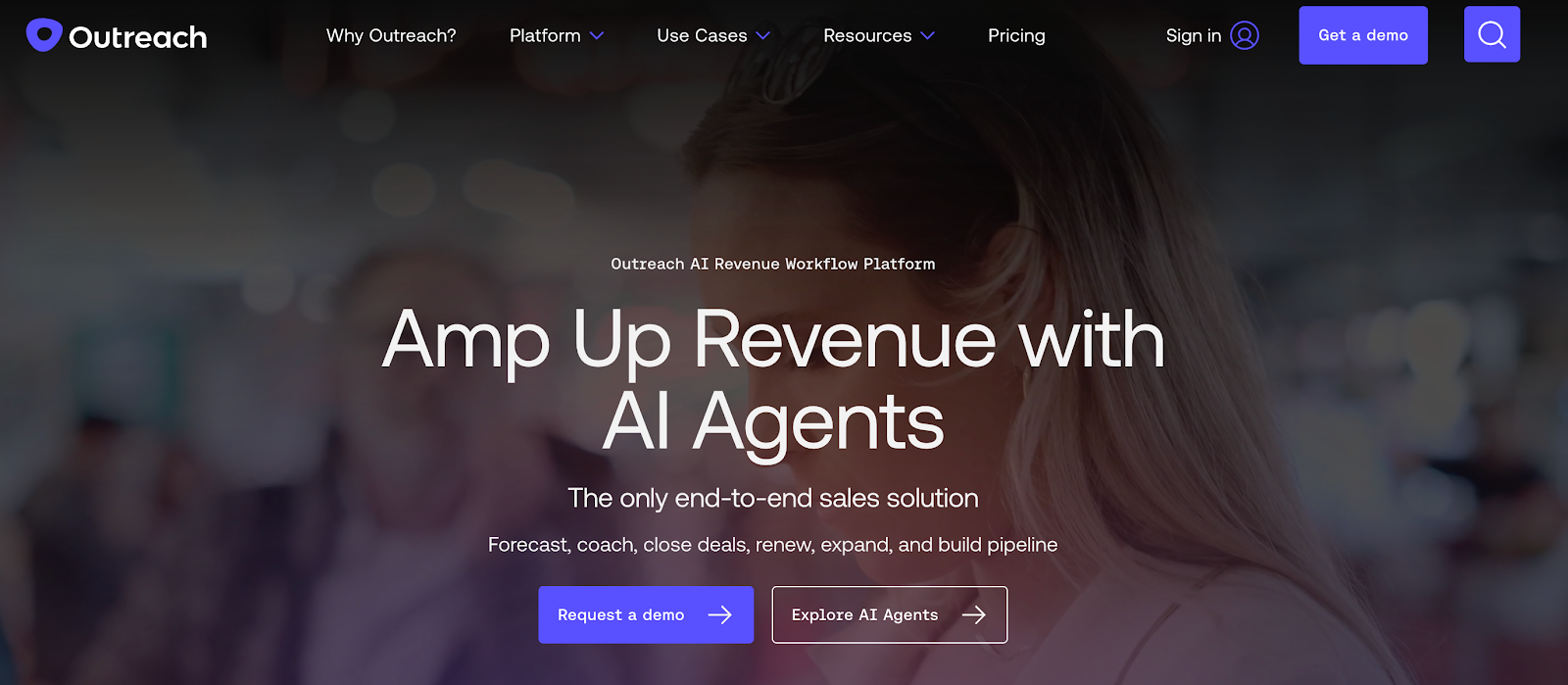
When you need structure that supports momentum, Outreach.io gives your sales team a system that keeps outreach consistent and measurable. It helps reps avoid mundane tasks and focus on timing, message quality, and follow-up.
Good for: Teams managing complex sales processes across outbound and account-based motions.
How Does Outreach.io Work?
Outreach.io uses an AI prospecting agent to help reps identify who to reach out to, when to reach out, and what to send. It automates follow-ups, tracks engagement across sequences, and surfaces data-driven insights that guide improvements in messaging and timing.
You can manage both inbound and outbound workflows, while Smart Accounts tools highlight who in the buying group is worth your time.
Standout Features
- AI support for lead prioritization, follow-up timing, and sequence engagement
- Inbound dashboards to capture and respond to leads without delay
- Multi-step outbound cadences with engagement scoring and reply tracking
- Reports that help you identify patterns in messaging and sequence performance
- Cadence tools that reduce tedious tasks and keep reps focused on deals
Pros
Outreach.io lets you manage future emails, calls, and tasks without letting leads fall through the cracks. You also get more value from each sequence when the platform shows you what’s resonating with your target audience.
Cons
Setup can be difficult if you handle complex workflows. Some teams report that support is inconsistent or slow to respond.
Pricing
- No pricing is published online.
8. People.ai
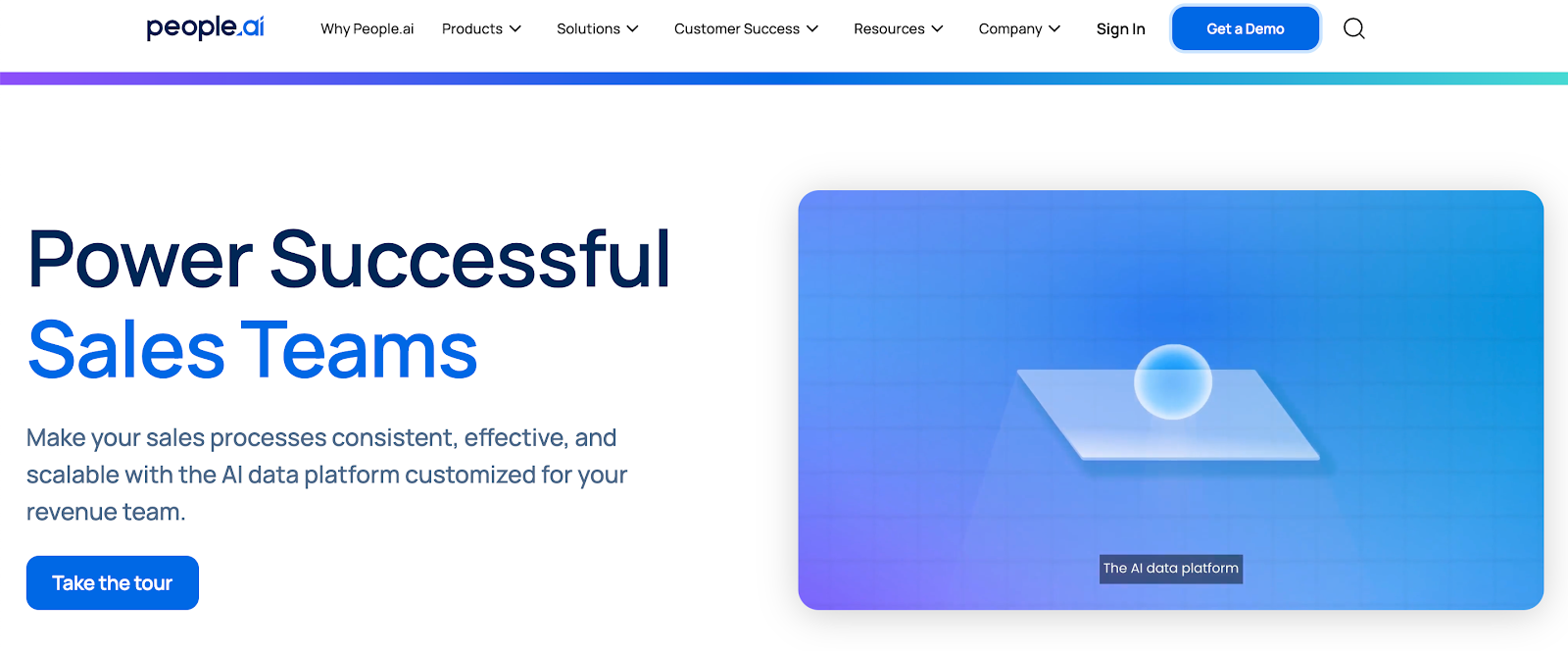
With People.ai, you won't have to manually log calls and update fields. It automates that work, captures reliable data, and surfaces AI-driven insights that guide reps toward faster close rates.
Good for: Small and midsize teams that want cleaner CRM data and clear visibility into which deals deserve attention.
How Does People.ai Work?
People.ai pulls activity from email, calendar, and conferencing tools, then pushes everything into your CRM system without touching a keyboard.
The platform analyzes past interactions to identify patterns that predict which opportunities move and which are stalling. Managers get alerts, next-step suggestions, and account summaries right inside the pipeline view.
Standout Features
- Relationship mapping that flags new contacts, shows influence, and estimates win likelihood
- Whitespace analysis to highlight upsell routes and competitor beachheads inside current accounts
- Generative summaries that point out risks, missing stakeholders, and recommended actions
Pros
You leverage AI to erase tedious tasks like manual data entry, freeing reps to focus on conversations. Predictive signals help you spend time where you get the most value and cut deals that will never close.
Cons
Pages can time out on slower connections. Advanced customization options are limited, so unique workflows may need workarounds.
Pricing
People.ai doesn't list pricing online.
Tips for Using AI Sales Tools
Are you using your AI sales tools with purpose? Build habits around them that drive sales success. These habits include the following:
Set Up Workflows Early
Don’t wait to get organized. Set clear rules for how leads are scored, how follow-ups happen, and how data moves between systems. Build your sales processes around the tool, not the other way around.
Use the Automation
Automation helps you move fast, but the real value comes from the insights. Check your analytics often. Look for trends in subject lines, reply timing, and conversion rates. These patterns help keep your messaging sharp.
Use AI to Coach, Not Replace Your Job
Let AI tools run the background tasks and surface data-driven insights. Use that time to send better messages and talk to the right people. AI is there to guide your work, not do the relationship building for you.
Turn Your Network Into a Sales Prospecting Advantage
If you’re serious about using AI to prospect better, start with a tool that gives you warm leads from day one.
Village helps you find real paths to investors, buyers, and decision-makers through the network you already have. It doesn’t rely on scraping or paid lists. You get context, history, and trusted connections—so your outreach feels personal, not cold.
Other tools help you scale volume. Village helps you close faster. You spend less time chasing and more time talking to people who are ready to move.
You can try it for free. No contracts, no setup delays. Just map your network and start requesting intros that actually lead somewhere.
Sign up for Village and see how much further your existing connections can take you.
FAQs About AI Sales Prospecting
How can I use AI for prospecting?
You can use AI to identify qualified leads, monitor buyer intent, and personalize your outreach. Many tools handle research, write messages, and surface the contacts most likely to engage, so you can spend more time on active selling instead of manual tasks.
How much does an AI sales agent cost?
The cost of an AI sales agent depends on the tool and the features you need. Entry-level plans often start around $30 per month, while more advanced platforms can be several hundred. Some tools, like Village, offer a free plan so you can try it without paying anything.
Can you use AI for sales?
Yes, AI can support nearly every part of your sales process. It can help you prioritize leads, automate follow-ups, uncover buying signals, and improve how you reach out to prospects. It works best when paired with your strategy and experience.
What are the five P's of prospecting?
The five P’s of prospecting are profile, prioritize, prepare, personalize, and persist. First, you define who you are targeting. Then you rank your leads, research them, craft thoughtful outreach, and follow up consistently to stay on their radar.









